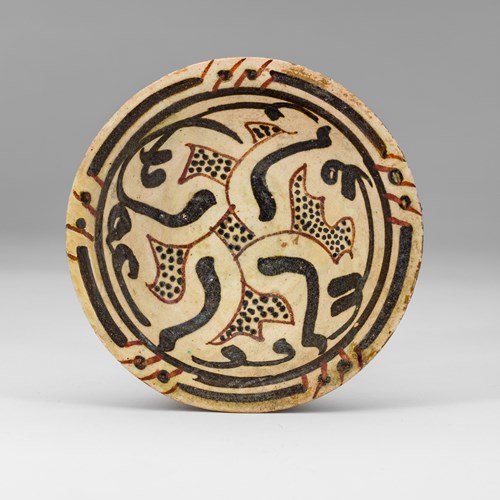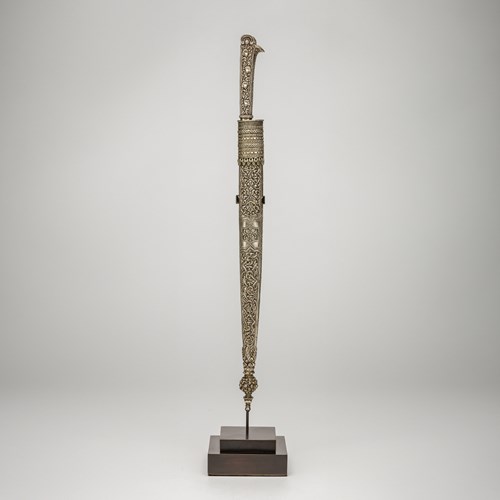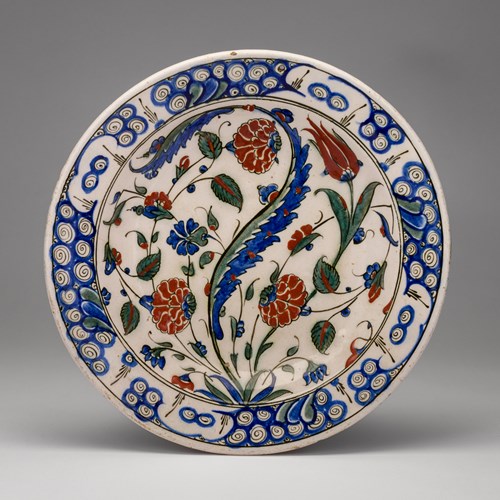Marketplace
Kashmiri Chair
Kashmiri Chair
Date 19th century
Epoque 19th century, 1750-1850, 1850-1900
Origine India
Medium polychrome, Carved wood, Velvet
Dimension 95 x 64 x 50 cm (37³/₈ x 25¹/₄ x 19⁵/₈ inches)
Rare carved wooden chair with polychrome Chinoiserie decoration with a European coat of arms. The seat upholstered with velvet; the front carved with dragons and Chinese symbols of longevity in medallions and squares. The sides of the seat carved with similar motifs. An open back with a central baluster-shaped splat decorated with a European coat of arms, surrounded by highly stylised Chinese symbols of happiness and simple scrolls of flower heads, curved top rail with protruding ends with a carved dragon, scrolling flower heads and Chinese symbols of longevity. The outer face of the central section painted with three stylised pseudo-Chinese characters, surrounded by carved stylised symbols, which are a combination of Tibetan vajra and Chinese happiness symbols and scrolls of flower heads. The back of the top rail carved with a frontally depicted dragon, floral scrolls and Chinese symbols of longevity, rest of the outer face decorated with dragons and Chinese symbols. The arms carved with a flower head and a long body of the dragon, each arm terminating in a rounded, stylised lion’s head. The front of the arms also decorated with dragons and Chinese characters. Front legs cabriole, decorated with dragons and Chinese symbols. Rear legs square, tapering outwards, decorated with dragons and Chinese symbols of happiness. There are four published folding tables with similar decorative work to the chair above, two made in Srinagar, Kashmir, and two in Lhasa, Tibet, in the 19th century. The Kashmiri tables, which were perhaps made for the British in Kashmir, are almost identical to the Tibetan ones. Their form and decoration copy Tibetan furniture design which is strongly based on Chinese decorative repertoire mixed with Indian motifs. The Kashmiri traders had a historically long presence in Tibet, especially in Ladakh in western Tibet and Lhasa in central Tibet and it seems likely the inspiration for Tibetan style furniture which was made in Kashmir originated from there. The emphasis on the very ornate decoration on the chair here fits the above criteria. For the illustrations of the two Kashmiri made folding tables, see Amin Jaffer, Furniture from British India and Ceylon, New Delhi, 2001, no. 117 and 118. For the Tibetan examples, see David Kaminsky, Wooden Wonders, Chicago, 2004, no. 51; Chris Buckley, Tibetan Furniture, London, 2005, no. 155.
Date: 19th century
Epoque: 19th century, 1750-1850, 1850-1900
Origine: India
Medium: polychrome, Carved wood, Velvet
Dimension: 95 x 64 x 50 cm (37³/₈ x 25¹/₄ x 19⁵/₈ inches)
Plus d'œuvres d'art de la Galerie








_T638568988938247202.jpg?width=500&height=500&mode=pad&scale=both&qlt=90&format=jpg)
